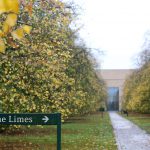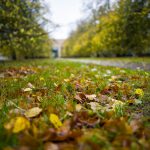
November 12, 2018, by Lindsay Brooke
Ceremony to ensure Sutton Bonington’s fallen are not forgotten
Two avenues of lime trees stand at the heart of the University of Nottingham’s Sutton Bonington Campus. Kingstonian Avenue, now known simply as The Limes, was planted nearly ninety years ago but few will be aware of the significance of these trees.
At the end of the 1920s the Old Kingstonian Association, alumni of the former agricultural college, agreed that the limes should be planted and some would be funded to remember fallen students and staff of the First World War.
This Remembrance Sunday the limes were the focus of a short ceremony as part of the commemorations marking the end of the Great War. At just before 11am a commemorative plaque and information board were unveiled to explain who planted the trees and why. The ceremony was followed by a minute’s silence.
 Prof Julian Wiseman, from the School of Biosciences, and Treasurer of the Old Kingstonian Association, said: “I have always had an interest in Campus history. The Association wanted to ensure that the story of the trees isn’t completely lost in the mists of time. This being the centenary of the end of the First World War we thought it a suitable time to highlight their story.”
Prof Julian Wiseman, from the School of Biosciences, and Treasurer of the Old Kingstonian Association, said: “I have always had an interest in Campus history. The Association wanted to ensure that the story of the trees isn’t completely lost in the mists of time. This being the centenary of the end of the First World War we thought it a suitable time to highlight their story.”
Old Kingstonian archives reveal the story
The origins of Sutton Bonington Campus stem from the Midland Agricultural and Dairy College, which was situated in the nearby village of Kingston-on-soar. The former college site is now long gone but it still lends its name to the alumni organisation. After the First World War, the college was relocated to the current, larger, site in the village of Sutton Bonington.
In 1930 The Kingstonian magazine announced that ‘A suggestion that an avenue of trees at College be planted by members is described in an accompanying circular to members. We hope it will meet with active approval.’
In 1931 the magazine was able to report that ‘members planted an avenue of trees on the road leading from the College Meterological Station to the Farm Buildings.’
The cost of each tree was 7/6 (seven shillings and sixpence) – 37.5 new pence.
No comments yet, fill out a comment to be the first










Leave a Reply